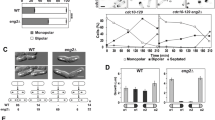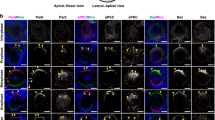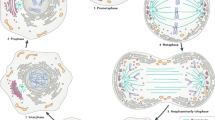Abstract
Polarity is key to the function of eukaryotic cells. On the establishment of a polarity axis, cells can vectorially target secretion, generating an asymmetric distribution of plasma membrane proteins. From Saccharomyces cerevisiae to mammals, the small GTPase Cdc42 is a pivotal regulator of polarity. We used a fluorescent probe to visualize the distribution of phosphatidylserine in live S. cerevisiae. Remarkably, phosphatidylserine was polarized in the plasma membrane, accumulating in bud necks, the bud cortex and the tips of mating projections. Polarization required vectorial delivery of phosphatidylserine-containing secretory vesicles, and phosphatidylserine was largely excluded from endocytic vesicles, contributing to its polarized retention. Mutants lacking phosphatidylserine synthase had impaired polarization of the Cdc42 complex, leading to a delay in bud emergence, and defective mating. The addition of lysophosphatidylserine resulted in resynthesis and polarization of phosphatidylserine, as well as repolarization of Cdc42. The results indicate that phosphatidylserine—and presumably its polarization—are required for optimal Cdc42 targeting and activation during cell division and mating.
This is a preview of subscription content, access via your institution
Access options
Subscribe to this journal
Receive 12 print issues and online access
$209.00 per year
only $17.42 per issue
Buy this article
- Purchase on Springer Link
- Instant access to full article PDF
Prices may be subject to local taxes which are calculated during checkout





Similar content being viewed by others
References
Vance, J. E. Phosphatidylserine and phosphatidylethanolamine in mammalian cells: two metabolically related aminophospholipids. J. Lipid Res. 49, 1377–1387 (2008).
van Meer, G., Voelker, D. R. & Feigenson, G. W. Membrane lipids: where they are and how they behave. Nat. Rev. Mol. Cell. Biol. 9, 112–124 (2008).
Cottrell, S. F., Getz, G. S. & Rabinowitz, M. Phospholipid accumulation during the cell cycle in synchronous cultures of the yeast, Saccharomyces cerevisiae. J. Biol. Chem. 256, 10973–10978 (1981).
Yeung, T. et al. Membrane phosphatidylserine regulates surface charge and protein localization. Science 319, 210–213 (2008).
Norden, C. et al. The NoCut pathway links completion of cytokinesis to spindle midzone function to prevent chromosome breakage. Cell 125, 85–98 (2006).
Whiteway, M. et al. The STE4 and STE18 genes of yeast encode potential β and γ subunits of the mating factor receptor-coupled G protein. Cell 56, 467–477 (1989).
Wiget, P., Shimada, Y., Butty, A-C., Bi, E. & Peter, M. Site-specific regulation of the GEF Cdc24p by the scaffold protein Far1p during yeast mating. EMBO J. 23, 1063–1074 (2004).
Garrenton, L. S., Stefan, C. J., McMurray, M. A., Emr, S. D. & Thorner, J. Pheromone-induced anisotropy in yeast plasma membrane phosphatidylinositol-4,5-bisphosphate distribution is required for MAPK signaling. Proc. Natl Acad. Sci. USA 107, 11805–11810 (2010).
Novick, P., Field, C. & Schekman, R. Identification of 23 complementation groups required for post-translational events in the yeast secretory pathway. Cell 21, 205–215 (1980).
Protopopov, V., Govindan, B., Novick, P. & Gerst, J. E. Homologs of the synaptobrevin/VAMP family of synaptic vesicle proteins function on the late secretory pathway in S. cerevisiae. Cell 74, 855–861 (1993).
Lewis, M. J., Nichols, B. J., Prescianotto-Baschong, C., Riezman, H. & Pelham, H. R. Specific retrieval of the exocytic SNARE Snc1p from early yeast endosomes. Mol. Biol. Cell 11, 23–38 (2000).
Vinnakota, K. C., Mitchell, D. A., Deschenes, R. J., Wakatsuki, T. & Beard, D. A. Analysis of the diffusion of Ras2 in Saccharomyces cerevisiae using fluorescence recovery after photobleaching. Phys. Biol. 7, 026011 (2010).
Faty, M., Fink, M. & Barral, Y. Septins: a ring to part mother and daughter. Curr. Genet. 41, 123–131 (2002).
Sata, M., Donaldson, J. G., Moss, J. & Vaughan, M. Brefeldin A-inhibited guanine nucleotide-exchange activity of Sec7 domain from yeast Sec7 with yeast and mammalian ADP ribosylation factors. Proc. Natl Acad. Sci. USA 95, 4204–4208 (1998).
Achstetter, T., Franzusoff, A., Field, C. & Schekman, R. SEC7 encodes an unusual, high molecular weight protein required for membrane traffic from the yeast Golgi apparatus. J. Biol. Chem. 263, 11711–11717 (1988).
Gurunathan, S., David, D. & Gerst, J. E. Dynamin and clathrin are required for the biogenesis of a distinct class of secretory vesicles in yeast. EMBO J. 21, 602–614 (2002).
Harsay, E. & Schekman, R. A subset of yeast vacuolar protein sorting mutants is blocked in one branch of the exocytic pathway. J. Cell Biol. 156, 271–285 (2002).
He, B. et al. Exo70p mediates the secretion of specific exocytic vesicles at early stages of the cell cycle for polarized cell growth. J. Cell Biol. 176, 771–777 (2007).
Zinser, E. et al. Phospholipid synthesis and lipid composition of subcellular membranes in the unicellular eukaryote Saccharomyces cerevisiae. J. Bacteriol. 173, 2026–2034 (1991).
Pruyne, D. & Bretscher, A. Polarization of cell growth in yeast. J. Cell Sci. 113 (Pt 4), 571–585 (2000).
Kaksonen, M., Sun, Y. & Drubin, D. G. A pathway for association of receptors, adaptors, and actin during endocytic internalization. Cell 115, 475–487 (2003).
Vida, T. A. & Emr, S. D. A new vital stain for visualizing vacuolar membrane dynamics and endocytosis in yeast. J. Cell Biol. 128, 779–792 (1995).
Burd, C. G. & Emr, S. D. Phosphatidylinositol(3)-phosphate signaling mediated by specific binding to RING FYVE domains. Mol. Cell 2, 157–162 (1998).
Katzmann, D. J., Stefan, C. J., Babst, M. & Emr, S. D. Vps27 recruits ESCRT machinery to endosomes during MVB sorting. J. Cell Biol. 162, 413–423 (2003).
Efe, J. A., Botelho, R. J. & Emr, S. D. Atg18 regulates organelle morphology and Fab1 kinase activity independent of its membrane recruitment by phosphatidylinositol 3,5-bisphosphate. Mol. Biol. Cell 18, 4232–4244 (2007).
Natarajan, P., Wang, J., Hua, Z. & Graham, T. R. Drs2p-coupled aminophospholipid translocase activity in yeast Golgi membranes and relationship to in vivo function. Proc. Natl Acad. Sci. USA 101, 10614–10619 (2004).
Cross, F. R. Cell cycle arrest caused by CLN gene deficiency in Saccharomyces cerevisiae resembles START-I arrest and is independent of the mating-pheromone signalling pathway. Mol. Cell. Biol. 10, 6482–6490 (1990).
Ziman, M. et al. Subcellular localization of Cdc42p, a Saccharomyces cerevisiae GTP-binding protein involved in the control of cell polarity. Mol. Biol. Cell 4, 1307–1316 (1993).
Richman, T. J., Sawyer, M. M. & Johnson, D. I. Saccharomyces cerevisiae Cdc42p localizes to cellular membranes and clusters at sites of polarized growth. Eukaryot. Cell 1, 458–468 (2002).
Chenevert, J., Corrado, K., Bender, A., Pringle, J. & Herskowitz, I. A yeast gene (BEM1) necessary for cell polarization whose product contains two SH3 domains. Nature 356, 77–79 (1992).
Bender, A. & Pringle, J. R. Use of a screen for synthetic lethal and multicopy suppressee mutants to identify two new genes involved in morphogenesis in Saccharomyces cerevisiae. Mol. Cell. Biol. 11, 1295–1305 (1991).
Toenjes, K. A., Sawyer, M. M. & Johnson, D. I. The guanine-nucleotide-exchange factor Cdc24p is targeted to the nucleus and polarized growth sites. Curr. Biol. 9, 1183–1186 (1999).
Riekhof, W. R. et al. Lysophosphatidylcholine metabolism in Saccharomyces cerevisiae: the role of P-type ATPases in transport and a broad specificity acyltransferase in acylation. J. Biol. Chem. 282, 36853–36861 (2007).
Trotter, P. J., Pedretti, J. & Voelker, D. R. Phosphatidylserine decarboxylase from Saccharomyces cerevisiae. Isolation of mutants, cloning of the gene, and creation of a null allele. J. Biol. Chem. 268, 21416–21424 (1993).
Wang, F. et al. Lipid products of PI(3)Ks maintain persistent cell polarity and directed motility in neutrophils. Nat. Cell Biol. 4, 513–518 (2002).
Kölsch, V., Charest, P. G. & Firtel, R. A. The regulation of cell motility and chemotaxis by phospholipid signaling. J. Cell Sci. 121, 551–559 (2008).
Mitra, P. et al. A novel phosphatidylinositol(3,4,5)P3 pathway in fission yeast. J. Cell Biol. 166, 205–211 (2004).
Folch, J., Lees, M. & Sloane Stanley, G. H. A simple method for the isolation and purification of total lipides from animal tissues. J. Biol. Chem. 226, 497–509 (1957).
Hermansson, M., Uphoff, A., Käkelä, R. & Somerharju, P. Automated quantitative analysis of complex lipidomes by liquid chromatography/mass spectrometry. Anal. Chem. 77, 2166–2175 (2005).
Koivusalo, M., Haimi, P., Heikinheimo, L., Kostiainen, R. & Somerharju, P. Quantitative determination of phospholipid compositions by ESI-MS: effects of acyl chain length, unsaturation, and lipid concentration on instrument response. J. Lipid Res. 42, 663–672 (2001).
Haimi, P., Uphoff, A., Hermansson, M. & Somerharju, P. Software tools for analysis of mass spectrometric lipidome data. Anal. Chem. 78, 8324–8331 (2006).
Acknowledgements
We thank C. McMaster (Dalhousie University, Halifax, Canada), S. Emr (Cornell University, Ithaca, USA), H. Pelham (MRC-LMB, Cambridge, UK), T. Levine (UCL, London, UK), D. Johnson (University of Vermont, Burlington, USA), K. Tanaka (Hokkaido University, Hokkaido, Japan), R. Collins (Cornell University, Ithaca, USA), E. Bi (UPENN, Philadelphia, USA), R. Li (Stowers Institute for Medical Research, Kansas City, USA), F. Cross (Rockefeller University, New York, USA), W. Guo (UPENN, Philadelphia, USA), C. Burd (UPENN, Philadelphia, USA), B. Andrews (University of Toronto, Toronto, Canada) and C. Boone (University of Toronto, Toronto, Canada) for providing strains and plasmids. We also thank C. McMaster for his comments on the manuscript. This work was supported by Canadian Institutes of Health Research (CIHR) grants 7075 and MOP4665. G.D.F. is the recipient of a CIHR postdoctoral fellowship. S.G. is the present holder of the Pitblado Chair in Cell Biology.
Author information
Authors and Affiliations
Contributions
G.D.F. and S.G. conceived the project and designed experiments; G.D.F. and M.H. carried out experiments; G.D.F., M.H., P.S. and S.G. analysed the data; G.D.F. and S.G. wrote the manuscript.
Corresponding author
Ethics declarations
Competing interests
The authors declare no competing financial interests.
Supplementary information
Supplementary Information
Supplementary Information (PDF 388 kb)
Supplementary Movie 1
Supplementary Information (MOV 1396 kb)
Supplementary Movie 2
Supplementary Information (MOV 149 kb)
Supplementary Table 1
Supplementary Information (XLSX 45 kb)
Supplementary Table 2
Supplementary Information (XLSX 33 kb)
Supplementary Table 3
Supplementary Information (XLSX 32 kb)
Supplementary Spreadsheet 1
Supplementary Information (XLS 37 kb)
Rights and permissions
About this article
Cite this article
Fairn, G., Hermansson, M., Somerharju, P. et al. Phosphatidylserine is polarized and required for proper Cdc42 localization and for development of cell polarity. Nat Cell Biol 13, 1424–1430 (2011). https://doi.org/10.1038/ncb2351
Received:
Accepted:
Published:
Issue Date:
DOI: https://doi.org/10.1038/ncb2351
This article is cited by
-
Silencing Notch4 promotes tumorigenesis and inhibits metastasis of triple-negative breast cancer via Nanog and Cdc42
Cell Death Discovery (2023)
-
A new look at Hsp70 activity in phosphatidylserine-enriched membranes: chaperone-induced quasi-interdigitated lipid phase
Scientific Reports (2023)
-
Crystal structures of phosphatidyl serine synthase PSS reveal the catalytic mechanism of CDP-DAG alcohol O-phosphatidyl transferases
Nature Communications (2021)
-
Lipid flippases in polarized growth
Current Genetics (2021)
-
A heat-sensitive Osh protein controls PI4P polarity
BMC Biology (2020)



